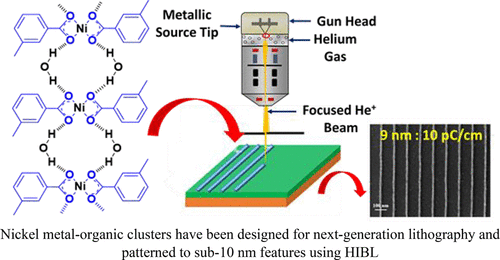当前位置:
X-MOL 学术
›
ACS Appl. Mater. Interfaces
›
论文详情
Our official English website, www.x-mol.net, welcomes your
feedback! (Note: you will need to create a separate account there.)
Development of Nickel-Based Negative Tone Metal Oxide Cluster Resists for Sub-10 nm Electron Beam and Helium Ion Beam Lithography.
ACS Applied Materials & Interfaces ( IF 8.3 ) Pub Date : 2020-04-20 , DOI: 10.1021/acsami.9b21414 Rudra Kumar 1 , Manvendra Chauhan 1 , Mohamad G Moinuddin 1 , Satinder K Sharma 1 , Kenneth E Gonsalves 2
ACS Applied Materials & Interfaces ( IF 8.3 ) Pub Date : 2020-04-20 , DOI: 10.1021/acsami.9b21414 Rudra Kumar 1 , Manvendra Chauhan 1 , Mohamad G Moinuddin 1 , Satinder K Sharma 1 , Kenneth E Gonsalves 2
Affiliation

|
Hybrid metal-organic cluster resist materials, also termed as organo-inorganics, demonstrate their potential for use in next-generation lithography owing to their ability for patterning down to ∼10 nm or below. High-resolution resist patterning is integrally associated with the compatibility of the resist and irradiation of the exposure source. Helium ion beam lithography (HIBL) is an emerging approach for the realization of sub-10 nm patterns at considerably lower line edge/width roughness (LER/LWR) and higher sensitivity as compared to electron beam lithography (EBL). Here, for the first time, a negative tone resist incorporating nickel (Ni)-based metal-organic clusters (Ni-MOCs) was synthesized and patterned using HIBL and EBL at 30 keV. This resist comprises a nickel-based metal building unit covalently linked with the organic ligand: m-toluic acid (C8H8O2). Dynamic light scattering confirmed a narrow size distribution of ∼2 nm for metal-organic cluster (MOC) formulations. High-resolution ∼9 nm HIBL line patterns were well developed at a sensitivity of 22 μC/cm2 and at a significantly low LER and LWR of 1.81 ± 0.06 and 2.90 ± 0.06 nm, respectively. Analogous high-resolution patterns were also observed in EBL with a sensitivity of 473 μC/cm2. Hence, the Ni-MOC-based resist investigated using HIBL and EBL elucidates the ability of its potential for the sub-10 nm technology node, under standard processing conditions.
中文翻译:

用于低于10 nm电子束和氦离子束光刻的镍基负离子金属氧化物团簇抗蚀剂的开发。
杂化金属-有机团簇抗蚀剂材料(也称为有机-无机)因其能够形成低至约10 nm或更低的图案的能力而展示了其在下一代光刻中的潜力。高分辨率的抗蚀剂图案化与抗蚀剂的相容性和曝光源的照射整体相关。氦离子束光刻(HIBL)是一种新兴的方法,与电子束光刻(EBL)相比,它可以在更低的线边缘/宽度粗糙度(LER / LWR)和更高的灵敏度下实现10 nm以下的图案。在这里,首次使用30 keV的HIBL和EBL合成并构图了包含镍(Ni)基金属有机簇(Ni-MOCs)的负型抗蚀剂。该抗蚀剂包含与有机配体共价连接的镍基金属结构单元:间甲苯甲酸(C8H8O2)。动态光散射证实了金属有机簇(MOC)配方的约2 nm窄尺寸分布。高分辨率〜9 nm的HIBL线图案在灵敏度为22μC/ cm2时以及LER和LWR分别为1.81±0.06和2.90±0.06 nm时都非常低的条件下得到了很好的开发。在EBL中也观察到类似的高分辨率图案,灵敏度为473μC/ cm2。因此,使用HIBL和EBL研究的基于Ni-MOC的抗蚀剂阐明了其在标准工艺条件下10纳米以下技术节点的潜力。分别为81±0.06和2.90±0.06 nm。在EBL中也观察到了类似的高分辨率图案,灵敏度为473μC/ cm2。因此,使用HIBL和EBL研究的基于Ni-MOC的抗蚀剂阐明了其在标准工艺条件下10纳米以下技术节点的潜力。分别为81±0.06和2.90±0.06 nm。在EBL中也观察到类似的高分辨率图案,灵敏度为473μC/ cm2。因此,使用HIBL和EBL研究的基于Ni-MOC的抗蚀剂阐明了其在标准工艺条件下10纳米以下技术节点的潜力。
更新日期:2020-04-23
中文翻译:

用于低于10 nm电子束和氦离子束光刻的镍基负离子金属氧化物团簇抗蚀剂的开发。
杂化金属-有机团簇抗蚀剂材料(也称为有机-无机)因其能够形成低至约10 nm或更低的图案的能力而展示了其在下一代光刻中的潜力。高分辨率的抗蚀剂图案化与抗蚀剂的相容性和曝光源的照射整体相关。氦离子束光刻(HIBL)是一种新兴的方法,与电子束光刻(EBL)相比,它可以在更低的线边缘/宽度粗糙度(LER / LWR)和更高的灵敏度下实现10 nm以下的图案。在这里,首次使用30 keV的HIBL和EBL合成并构图了包含镍(Ni)基金属有机簇(Ni-MOCs)的负型抗蚀剂。该抗蚀剂包含与有机配体共价连接的镍基金属结构单元:间甲苯甲酸(C8H8O2)。动态光散射证实了金属有机簇(MOC)配方的约2 nm窄尺寸分布。高分辨率〜9 nm的HIBL线图案在灵敏度为22μC/ cm2时以及LER和LWR分别为1.81±0.06和2.90±0.06 nm时都非常低的条件下得到了很好的开发。在EBL中也观察到类似的高分辨率图案,灵敏度为473μC/ cm2。因此,使用HIBL和EBL研究的基于Ni-MOC的抗蚀剂阐明了其在标准工艺条件下10纳米以下技术节点的潜力。分别为81±0.06和2.90±0.06 nm。在EBL中也观察到了类似的高分辨率图案,灵敏度为473μC/ cm2。因此,使用HIBL和EBL研究的基于Ni-MOC的抗蚀剂阐明了其在标准工艺条件下10纳米以下技术节点的潜力。分别为81±0.06和2.90±0.06 nm。在EBL中也观察到类似的高分辨率图案,灵敏度为473μC/ cm2。因此,使用HIBL和EBL研究的基于Ni-MOC的抗蚀剂阐明了其在标准工艺条件下10纳米以下技术节点的潜力。


















































 京公网安备 11010802027423号
京公网安备 11010802027423号